|
Families of Jules & Théodore Porgès
|
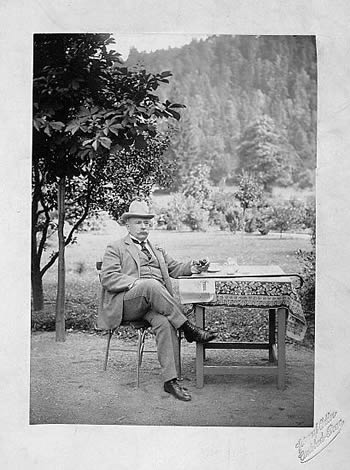
Jules Porgès
(b. 25/05/1839 Vienna, d. 20/09/1921 Paris)
married Rose-Anne WODIANER
"Fotograf Adler, Carlsbad, Prag"
(Courtesy of Comte Michel de la Forest Divonne) |
|
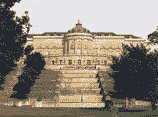
The
Porgès Château at Rochefort en Yvelines (near Paris)
Jules Porgès
built the Château of Rochefort
en Yvelines, in the Paris neighbourhood, for his wife and his daughter.
He and his wife are buried in the Rochefort cemetery.
His death was declared by his grand-son-in-law,
Count Arnaud de Gontaut-Biron.
In the 1980's the property
was transformed by its Japanese owner into a private
golf club.
In the 2010's the castle was transformed into a residential conference center
.
|
|
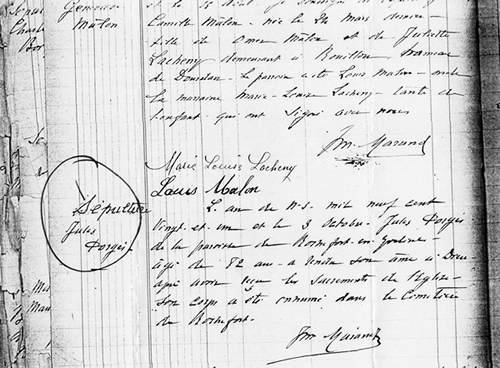
L'an de N.S. mil neuf cent
vingt-et-un et le 9 octobre, Jules Porgès,
de la paroisse de Rochefort-en-Yvelines,
âgé
de 82 ans a rendu son âme à Dieu, après
avoir reçu les sacrements de l'Église.
Son corps a été inhumé dans le
cimetière de Rochefort.
Death register of the
parish of Rochefort. Courtesy of Madeleine Sandrea |
A
dark side .... Jules Porgès and the Dreyfus Affair
Guerre civile en puissance
... Et l'antisémitisme? Si
nous en disions deux mots?
L'autre jour M. Drumont écrivait
que "le sang des juifs ruissellerait sur les échafauds".
En vain les condamnés offriraient leurs
biens pour sauver leur tête : on les leur aurait déjà
pris.
C'est bien de l'antisémitisme, cela, je suppose.
On allèguera peut-être que c'est là
une opinion individuelle et que M. Drumont a été
obligé d'aller jusqu'en Afrique pour trouver un mandat
de député français.
Il n'en est pas
moins vrai que son journal se trouve dans tous les châteaux,
dans toutes les sacristies et que son coadjuteur Guérin
a tenu le gouvernement en échec pendant plusieurs
semaines, au coeur même de Paris, avec une troupe
armée.
Il y a fallu, sans doute, la couardise du
ministère : aussi l'audace des révoltés.
Je n'ai pas besoin de rappeler les troubles d'Alger réprimés
par la République avec moins de rigueur que les grèves
du François ou de Chalon.
L'affaire Dreyfus ainsi
se trouve mise dans son cadre.
Un malheureux qui était
au bagne depuis plusieurs années vient d'être
reconnu innocent.
Puisqu'il n'est pas juif les juges auront
toute liberté de lui faire justice.
J'ai longtemps cru que le procès de Dreyfus, d'Esterhazy,
de Zola, de Picquart, marqueraient l'étiage des sauvageries
où pouvaient se répandre l'esprit romain dans
la patrie de la Revolution française.
Je n'en suis
plus du tout certain aujourd'hui, et il y a de cela plusieurs
causes.
D'abord la psychologie des juifs ne les pousse pas
à se mettre en bataille.
Leur histoire les montre
capables de révolte et de ténacité
combative, mais ils ont remarquablement conservé
le trait oriental du courage passif poussé jusqu'à
l'extrême.
Peu d'entre nous peut-être auraient
été capables de supporter dans un stoïque
silence les quatre années de tortures à l'île
du Diable.
Mais, l'épreuve traversée, se trouvant
face à face, en présence de nouveaux juges,
avec Boisdeffre, avec Mercier, quel Celte ou quel Latin
ne leur eût cinglé la face de leur crime?
Dreyfus
innocent, Dreyfus survivant, invaincu, au plus effroyable
supplice, a pu demeurer maître de lui-même.
Je l'admets brisé par le désespoir et la maladie.
Même dans l'agonie, il en est qui eussent crié.
Sa mentalité de race, sa discipline de soldat ne
lui ont pas permis ce beau coup de théatre.
Pour ses coreligionnaires, on peut dire d'une façon
générale qu'ils ont été trop
méthodiquement bâtonnés pendant trop
de siècles pour n'en avoir pas gardé quelque
chose comme un pli d'échine qui les dispose au rôle
de martyrs.
Et puis, il y dans les races des dons de flexibilité
ou de raideur.
Le colon d'Amérique n'a jamais pu
soumettre le Peau-Rouge qui se refuse au travail servile
et n'avait pour préoccupation, aussitôt domestiqué,
que de tuer son maître.
Au contraire, les nègres
d'Afrique ont prospéré dans l'esclavage.
C'est
ainsi que l'affaire Dreyfus a trouvé les Juifs plus
accoutumés à l'injustice, plus façonnés
aux coups qu'il n'aurait fallu pour une énergie de
victoire.
De fait le prolétariat juif n'est pas plus
que le prolétariat dit chrétien en état
de se défendre.
Mais les grands seigneurs d'Israël,
comme tous les observateurs de bonne foi l'ont noté,
loin de s'organiser en "syndicat" - épouvantail
destiné à masquer le trop réel fonctionnement
de la caisse noire romaine - ne souhaitaient rien tant que
le silence sur le prisonnier de l'Ile du Diable.
L'un d'eux
dit ce mot charmant à un "Intellectuel"
de mes amis :
"Vous nous défendez bien.
Mais
je puis bien vous dire que nous aimerions mieux n'être
pas défendus, car alors on ne nous attaquerait pas".
Et comme l'autre répondait :
"Je
ne vous défends pas, je défends la justice
tout simplement", le Grand Juif répliqua
"Ah si seulement vous pouviez la défendre
à propos d'un chrétien!".
J'ai déjà
cité le propos d'un banquier juif, un directeur d'un
grand journal de Paris, le jour même du verdict de
Rennes :
"Quelle chance! s'il avait été
acquitté, c'est à nous qu'on aurait fait payer
les pots cassés".
Il est certain que cette
campagne a eu pour résultat de terrifier tous les
juifs de "la haute", reniés maintenant
par l'aristocratie bien pensante qui honorait jadis leurs
chasses de sa présence et maintenant fait masse derrière
M. Drumont.
Je
ne dis rien des renégats, de Porgès à
Arthur Meyer, servant à quatre pattes "le Saint-Père
et le Roi ", en échange des affronts qui ne
leur sont pas ménagés.
Le plus clair résultat
de tout ceci, c'est que la mentalité juive est un
des facteurs les plus importants de la situation défavorable
faite présentement aux fils d'Israël dans la
France catholique et républicaine.
Mais la mentalité
chrétienne, comme on pense, ne laisse pas d'y tire
pour sa bonne part. Notre républicaine "chrétienté" se compose d'éléments divers.
Nourri
dans la haine du juif, le clergé d'église
et de couvent regrette ses anciens bûchers, instruments
fameux des "actes de foi".
La "race
déicide" y figurait en compagnie de toutes
les hérésies, et c'est un des signes de notre
temps que l'antisémitisme de M. Drumont se complète
de l'antiprotestantisme de M. Georges Thiébaud et
de l'antilibre-pensée de M. Jules Lemaltre.
Trois
têtes sous la même calotte romaine.
Je n'ignore pas qu'en face de cette prédication d'intolérance,
se dresse le pouvoir laïque de justice et de liberté
issu de la Révolution française.
....
Excerpts from La Honte (1903) by Georges
Clémenceau
1899 Affaire Dreyfus. I, L’Iniquité
1899 Affaire Dreyfus. II,Vers la réparation
1900 Affaire Dreyfus. III, Contre la justice
1900 Affaire Dreyfus. IV, Des juges
1901 Affaire Dreyfus. V, Justice militaire
1902 Affaire Dreyfus. VI, Injustice militaire
1903 Discours pour la liberté
1903 Affaire Dreyfus. VII, La Honte
Captain Alfred Dreyfus was the highest-ranking
Jewish artillery officer in the French army.
He was charged
with passing military secrets to the German Embassy in Paris,
and in 1894 was convicted of treason and imprisoned on Devil's
Island.
The conviction was based on documents which were
found in the waste-paper basket of the German military attaché,
Major Max von Schwartzkoppen, and which initially appeared
to the French military authorities to implicate Dreyfus.
Fearing that the sometimes anti-Semitic press would learn
of the affair and accuse the French army of covering up
for a Jewish officer, the French military command pushed
for an early trial and conviction.
By the time they realised
that they had very little evidence against Dreyfus (and
that what they had was not at all conclusive), it was already
politically impossible to withdraw the prosecution without
provoking a political scandal that some feared would have
brought down the French government [citation needed]. The
subsequent court martial was notable for numerous errors
of procedure.
Most notably, the defense was unaware of a
secret dossier which the prosecution provided to the military
judges.
The withholding of this dossier made Dreyfus' trial
illegal under French law.
The dishonourable discharge of
Dreyfus.
L'Aurore's front page on 13 January 1898 features
Emile Zola's open letter to the French President Félix
Faure regarding the Dreyfus Affair.
Alfred Dreyfus was put on trial in 1894 and was accused
of espionage, found guilty and sentenced to life in prison
on Devil's Island.
In June 1899 the case was reopened, following
the uncovering of exonerating evidence, and France's Court
of Cassation overturned his conviction and ordered a new
court martial.
Despite the new evidence presented at his
new military trial, Dreyfus was reconvicted in September
and sentenced to 10 years in prison.
He was subsequently
pardoned by President Émile Loubet and freed, but
would not be formally exonerated until July 12, 1906, when
the Court of Cassation annulled his second conviction.
He was thereafter readmitted to the army and made a knight
in the Legion of Honour.
Dreyfus was recommissioned to serve
behind the lines of the Western Front during World War I
as a Lieutenant-Colonel of Artillery though he did perform
some front-line duties in 1917.
He served his nation with
distinction beyond his natural retirement age.
The Dreyfus
Affair was one of the most important scandals of the French
Third Republic, if not the most important.
The Affair
deeply divided the country into Dreyfusards (those supporting
Dreyfus) and anti-Dreyfusards (those against). Generally
speaking, royalists, conservatives and the Catholic Church
(the "right wing") were anti-dreyfusards while
socialists, republicans and anticlericalists (the "left
wing") were dreyfusards, though there were exceptions.
The Dreyfus Affair could not have happened in
a country wholly antisemitic, nor in a country devoid of
antisemitism.
Indeed, Alfred Dreyfus, openly Jewish, had
been admitted to the most selective military schools in
the country, and had been commissionned into a sensitive
position; this was, at the time, unheard of in several other
European countries, where policies of discrimination were
often in place.
The Affair then greatly split French society
and had important political repercussions; it contributed
to the radicalization of opinion against the Catholic Church
and the "clerical" party, which resulted in the
1905 French law on the separation of Church and State.
The writer Émile Zola is often thought to have exposed
the affair to the general public in a famously incendiary
open letter to which the French statesman and journalist
Georges Clémenceau appended the
eye-catching title "J'accuse!" (I Accuse!) ; it
was published January 13, 1898 in the newspaper L'Aurore
(The Dawn).
In the words of historian Barbara Tuchman, it
was "one of the great commotions of history."
Zola was convicted of libel and was forced to flee the country.
Faure
to which the French statesman and journalist Georges Clemenceau
appended the eye-catching title "J'accuse!" (I
Accuse!) ; it was published January 13, 1898 in the newspaper
L'Aurore (The Dawn).
In the words of historian Barbara Tuchman,
it was "one of the great commotions of history."
|
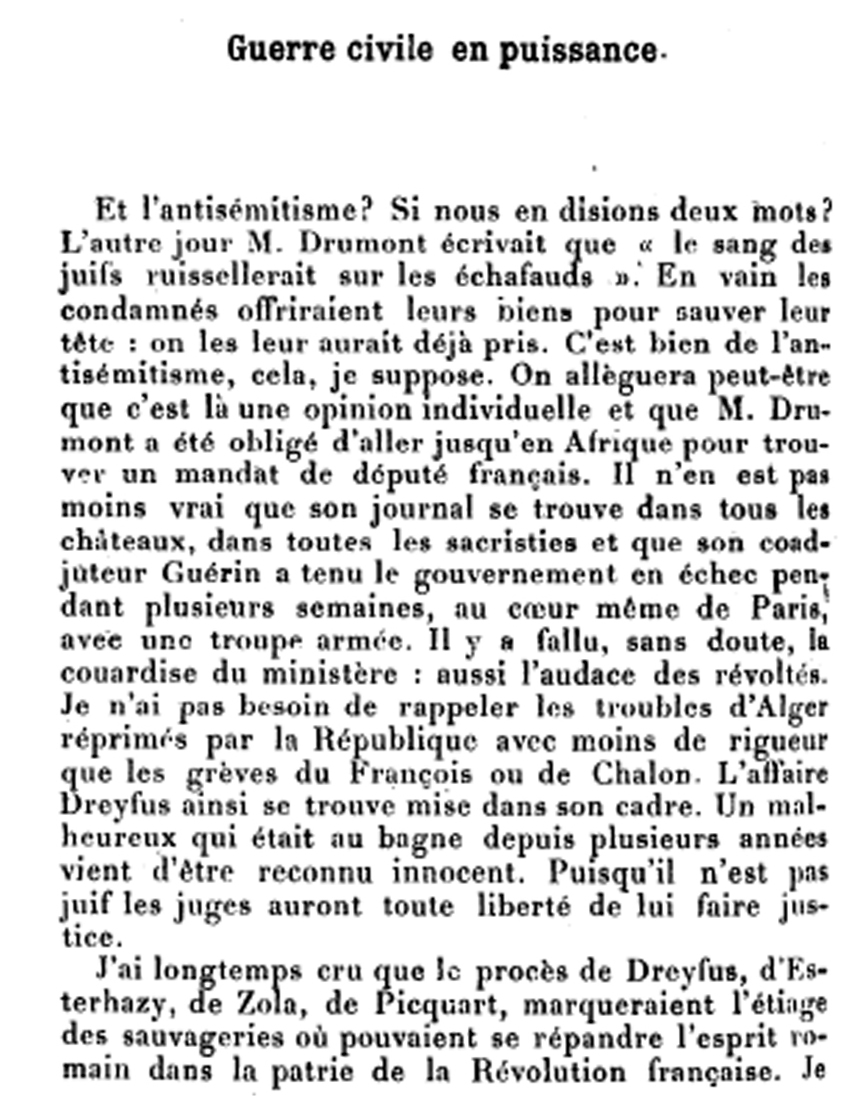 |
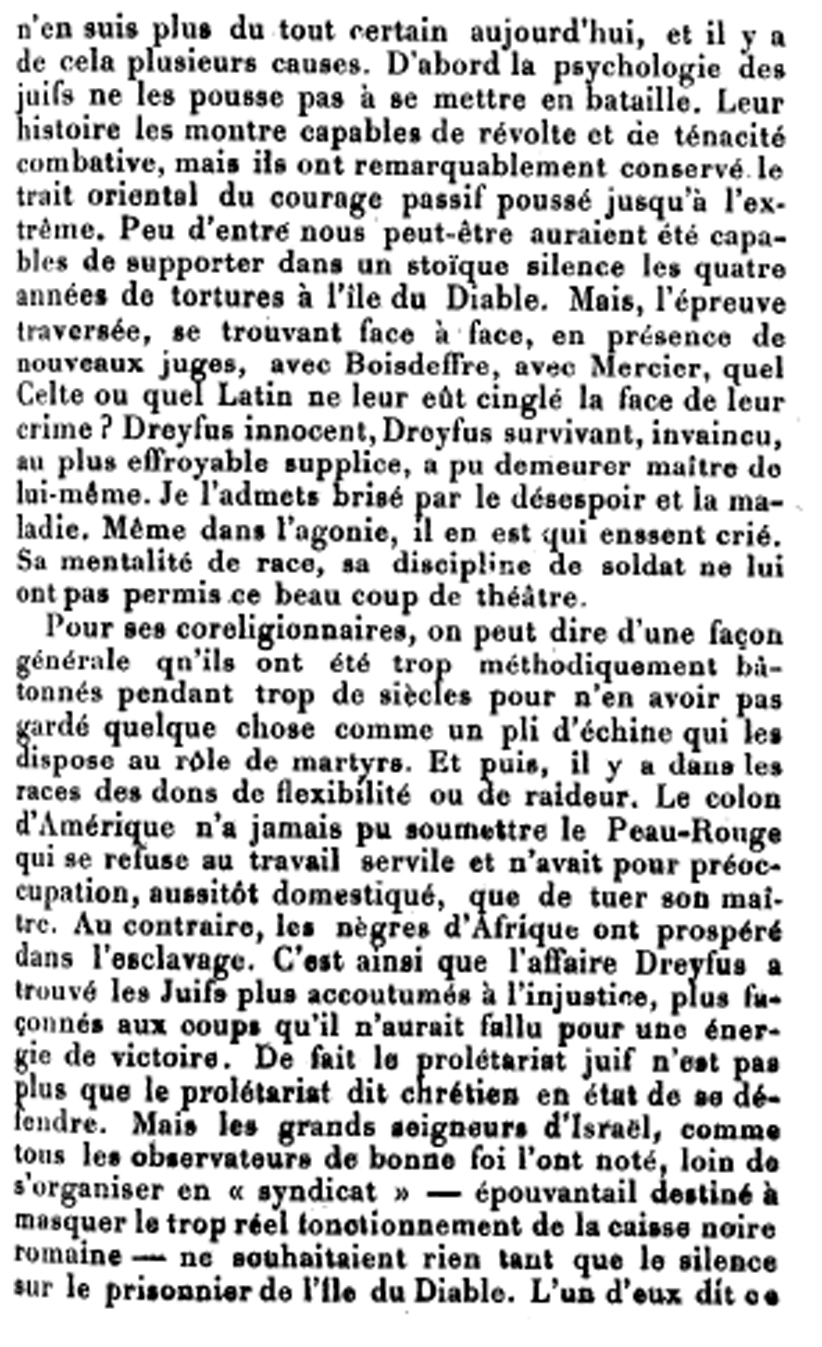 |
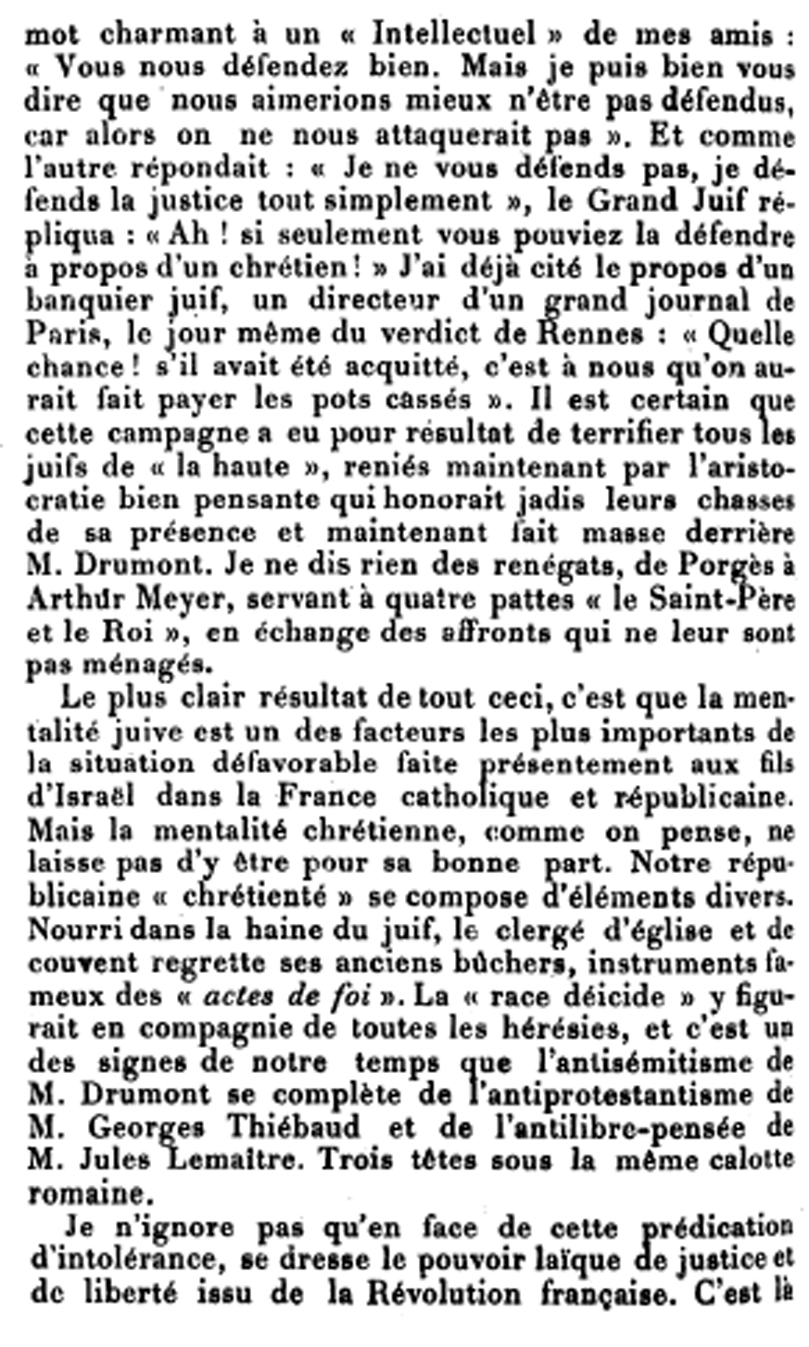 |
 |
A bright side ....
Henriette de la Ferté Meun, the daughter of Jules Porgès nominated
in 2005
Juste de France for her righteous actions during WWII
As reported by
Yad Vashem, Henriette Porgès, Marquise de la Ferté Meun,
has
been nominated in 2005 Juste de France for her righteous
actions during WWII.
LES JUSTES DE FRANCE >
Tous les Justes de France Dossier
n° 10583
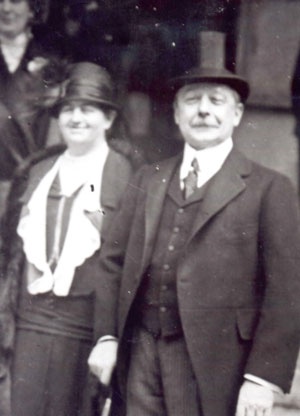
Le 25 mai 2005, l'institut Yad Vashem de Jérusalem
a décerné à la Marquise Henriette de la Ferté
et à son mari le Marquis Eugène de la Ferté
le titre de "Juste parmi les Nations". |
Le marquis Eugène de la Ferté, propriétaire terrien, ainsi que sa femme Henriette étaient issus d’une vieille famille aristocratique et résidaient à Mâron (Indre).
Eugène y exerçait la charge de maire.
En 1942, après la rafle du Vel’d’Hiv’, le couple Halkin et sa fillette de 3 ans décidèrent que Paris devenait trop dangereux pour les Juifs et se réfugièrent à Mâron.
Ils y furent rejoints par leurs proches : quatre membres de la famille Felzen ; quatre membres de la famille Pinszomski et trois membres de la famille Segal.
En tout, quatorze personnes.
Dès leur arrivée, Eugène de la Ferté et Jules Gilbert, instituteur et secrétaire de mairie, leur reconnurent le statut de réfugiés, accordé aux populations évacuées pendant la campagne militaire ou aux habitants des régions annexées par l’Allemagne ayant opté pour la France.
Ce statut permit aux réfugiés de bénéficier d’une aide officielle.
Le marquis et Jules Gilbert leur trouvèrent un logement qu’ils équipèrent de lits, matelas, couvertures, une cuisinière à bois et des ustensiles de cuisine.
Ils leur attribuèrent des allocations et des titres d’alimentation.
Les enfants furent scolarisés et Madame la marquise fut d’une grande aide car, grâce à elle, ils prenaient les repas à la cantine des écoles.
Elles leur procura des vêtements et des chaussures.
Le marquis donna une machine à coudre à M. Pinszomski pour qu’il puisse travailler et offrit à Albertine Halkin un travail de secrétariat.
M. Halkin trouva un emploi chez des fermiers.
Tout le village connaissait leur origine mais personne n’a parlé.
Lors des incursions allemandes, les paysans avertis les cachaient dans les fermes ou les greniers.
Les risques courus pour cette aide étaient énormes car la milice de la région sévissait cruellement.
Quelques proches des réfugiés furent massacrés non loin au Puits de Guéry.
Le couple de la Ferté et Jules Gilbert qui aidait aussi le marquis, étaient d’une grande bonté et surtout « n’aimait pas les Allemands ». |
" The Felzen family left Poland for France in 1910.
They
had three children: Albertine, Henri and Pauline.
Mr Felsen
volunteered during the First World War.
In 1920, the family
became French citizens and bought a cafe in 6th arrondissement
of Paris.
In 1941, Albertine was arrested by the police but as a French
national was subsequently released.
Her husband managed to
escape, taking shelter with non-Jewish friends and then fleeing
into non-occupied France.
In 1942, Albertine, aware of the growing threat, abandoned
everything and fled into non-occupied France with her three-year-old
daughter Nicole.
There she rejoined her family in the Indre where they were
sheltered by the Marquis Eugène de la Ferté,
the mayor of the village of Maron, and his wife.
The couple,
recognizing the Felzens' destitution, found them shelter,
bedding, blankets, food and heating.
The Felzens were not the only family protected by the mayor
and his wife ; they also cared for the Halkin and Pinszowski
families.
Their generosity was unflagging.
At great risk
to their own safety, they not only helped but saved 15 members
of a single family."
Source : http://www.yadvashem-france.org/justes-france/?mode=detail&number=10583
LES JUSTES DE FRANCE > Tous les Justes de France > Dossier
n° 10583
Date de nomination : 2005
DE LA FERTE Eugène (René????) , DE LA FERTE
Henriette
Maron :Château de Rezay, Indre, Centre
La famille Felzen arrive de Pologne en 1910.
Trois enfants vont naître : Albertine, Henri et Pauline.
M. Felzen s'est engagé en 1914/1918.
La famille est naturalisée française en 1920
et achète un café dans le 6ème arrondissement à Paris.
En
1941, Albertine est arrêtée par la police
puis relâchée car française.
Son mari a réussi à s'enfuir, à se
réfugier chez des amis non-juifs et à rejoindre
la zone libre.
En 1942, Albertine sent le danger grandir et
abandonne tout pour partir avec sa fille de 3 ans, Nicole,
pour la zone libre.
Elle rejoint sa famille dans l'Indre.
Ils sont accueillis par le Marquis Eugène de la Ferté,
maire du village de Maron, et sa femme.
Voyant leur dénuement,
ils leur procurent un logement, des lits, des couvertures,
de la nourriture et un poêle.
La famille Felzen n'est pas la seule famille protégée
par le maire et sa femme. Il y a eu aussi les familles Halkin,
Pinszowski.
Leur générosité est inlassable.
Ils ont sauvé et aidé 15 personnes d'une même
famille au péril de leur vie.
Read also : Marquise Elly de la Ferté Meun : Juste parmi les Nations http://www.ajpn.org/juste-Elly-de-la-Ferte-Meun-795.html |
Another
side of Mme Porgès social and private
life
|
Paul Morand
Journal d'un Atttaché d'Ambassade
(1916 - 1917)
La Table Ronde (Paris)
|
|
Madame J. Porgès has a hospital in Rochefort, according
to Proust who tells the following story:
"A wounded French soldier,
coming out of a coma, found Mme Porgès standing at his
bedside; upon hearing her accent like some German Shylock,
he cried out, "Oh God, I've been taken prisoner!"" |
|
A small dinner at the Ritz with Hélène and
Proust.
Proust describes the startling personality of old Lubersac,
greedy, mean, who beat his coachmen, refused to repair his
rental properties and never paid for the services of Dr. Proust.
Having been the lover
of Mme. Porgès, Lubersac became
fiercely anti-Semitic and forced each of his sons to fight
a duel with one or another of the Rothschilds at the time of
the Dreyfus affair; as there weren't enough of these latter,
he had to wait for the youngest of them to attain his majority
so he could challenge him. |
|
Biographies
of Jules Porgès
|
Jules
Porgès (1839-1921)
 |
Mining
magnate. Born in Prague, settled in Paris in the 1860s
and became a leading diamond merchant.
Both Alfred Beit and Sir Julius Wernher worked for him
and were sent by him to Kimberley.
He himself arrived there in 1875 and became a successful
operator in shares, claims and stones, later extending
operations (establishing the firm of H. Eckstein) to
the Witwatersrand in 1887.
In 1880 he returned to Europe. He retired from business
in 1889, but long outlived both Beit and Wernher. |
|
|
Sir Julius Charles WERNHER
(1850-1912) 
Mining magnate.
Born in Darmstadt, Germany, where his father was attached
to the Grand-Ducal court, he entered a London bank as
a learner, served in the Prussian cavalry in the Franco-German
War of 1870-1871, and, like Alfred Beit, took a post
in Paris with Jules Porgès. Porgès
sent him to Kimberley, where he was elected to the Mining
Board and soon gained wealth and prominence. After the
discovery of the Rand he extended his operations to
the Transvaal. In 1888 he became one of the four original
'Life Governers' of De Beers Consolidated Mines. He
settled in London as Porgès' partner and,
when the latter retired in 1889, continued operations
under the name of Wernher, Beit and Co., the largest
mining house in South Africa, if not in the world, controlling
the Rand Mines group and other huge interests. Apart
from occasional visits to South Africa, he spent the
rest of his life in England. A noted art collector,
he died, leaving the largest South African fortune on
record - over £11 000 000. |
Alfred BEIT (1853-1906) 
Capitalist and co-founder with Cecil
Rhodes of Southern Rhodesia.
Born in Hamburg in the same year as Rhodes, of an old
Jewish family. He learnt the diamond trade under Jules
Porgès in Amsterdam and elsewhere. In 1875
he went to Port Elizabeth on behalf of his cousins,
the Lipperts, who sent him to Kimberley as their representative.
There he came into touch with Julius Wernher and with
Cecil Rhodes. Attaining considerable prosperity as a
diamond merchant, he became a member of the firm of
Jules Porgès and Co., and on the retirement
of Porgès, he and Wernher converted this
firm in 1884 to Wernher, Beit and Co. Returning to England
he joined forces with Rhodes in his efforts to amalgamate
the diamond mines, which resulted in the foundation
of De Beers. A Life Governor of De Beers, he was one
of the principal figures in the foundation of the Chartered
Company and in the first efforts to open up Rhodesia.
Wernher, Beit and Co. presently became leaders in Barberton
and then in the Witwatersrand gold industry. Beit visited
Rhodesia in the very early days, but kept his headquarters
in London. Unlike Rhodes, he did his utmost to keep
out of politics, though his friendship with him remained
undiminished, and he was one of the main trustees and
heirs under his will. Upon Alfred Beit's death the Beit
Trust came into existence. He also bequeathed enormous
sums for university education and research in South
Africa, Rhodesia, Britain and Germany. |

Große
Jüdische National-Biographie (S. Wininger) :
" He came to Paris
in the 1860's and played a prominent role in the emerging
South-African mining industry . He became one of the first
mining tycoons, with Rhodes and Werner-Beith .
Even as a naturalized French, he provided a lot of help to
the Austrians much before the war. His Palace in Paris was
the center of the fashionable Parisian Life. His wife, born
Wodianer, assisted him in the achievement of their social
obligations with an exceptional kindness. Mrs. Anna Porgès
was the sister of Mrs. Ida Gutmann, widow of the industrialist
Wilhelm v. Gutmann and Mrs. Pringsheim of Berlin.
Jules Porgès was one of the most eminent art collectors
in Paris. He was an exceptional expert in Dutch art masterpieces,
which were represented, in his gallery of avenue Montaigne,
by the beautiful and rare paintings of van Dyck, Franz Hals
and Ruysdael. "
(Neue Freie Preß. 4 Oct 1921)
Dictionary
of South African Bibliography ( Vol. II, Pretoria, 1983)
:
"
Diamond merchant and mining entrepreneur, was of Jewish parentage
and brought up in Prague, where his father was a master jeweller.
During the 1860's, he settled in Paris, changed his name Julius
(originally Yehuda) to Jules and quickly amassed a fortune
as a diamond merchant.
At the time of the Kimberley discoveries, Jules Porgès
& Co, was the greatest and wealthiest diamond firm in
the world, with a large stake in the diamond-cutting trade
of Amsterdam.
Porgès quick to recognize that the output from the
Griqualand West mines would transform the whole nature and
scale of the world market in precious stones, in 1873 sent
Alfred Beit and Julius Wernher to South Africa as the firm's
representatives, with instructions to report regularly on
new discoveries.
Three years later, Porgès himself arrived in Kimberley,
immediately becoming a major figure in the local gem stone
market as well as in the buying and selling of digger's claims.
He thus played the complex , double role of producer and merchant
of diamonds.
At first, his interests extended to all four of the principal
mines (De Beers, Bultfontein, Dutoitspan, and Kimberley),
but by 1879 he had come to concentrate increasingly on the
Kimberley mine, setting up a subsidiary to control it, the
Compagnie Française de Diamant du Cap de Bonne Espérance,
which had an initial capital of fourteen million francs divided
in 500 francs shares.
Within two years, the French company was paying out dividends
of eighty francs per share.
Through Beit, Porgès became a close business associate
of C.J. Rhodes, who eventually induced him to persuade the
French shareholders to dispose of their interests to the new
De Beers combine.
In this way, Porgès became a leading figure in the
amalgamation movement, which culminated in August 1887, when
a syndicate, formed by the Rothschilds, advanced the sum of
£1,400,000 for the purchase of the French shares.
Porgès was related to Rudolphe Kann, a famous financier
of Paris, and through him succeeded in interesting the Rothschilds,
who provided the capital that Rhodes needed to buy Kimberley
Central shares.
Though Beit is usually credited with raising money that brought
Barney Barnato to terms, it was in fact Porgès who
was responsible.
Meanwhile, Porgès had returned to Europe in 1880, but
revisited South Africa after the opening-up of the Witwatersand
gold fields.
In association with Beit and Wernher, but also making much
use of the services of Hermann Eckstein and Eduard Lippert,
Porgès acquired stakes in many mining properties in
and around Johannesburg.
He also was the founder of the famous mining and financial
group known as the 'Corner House' (their offices were erected
on a corner at the site of Market Square, Johannesburg).
In 1890, he retired from South African business, most of his
widespread interests being taken over by the newly established
firm of Wernher, Beit & Co.
Porgès was a man of great elegance and charm and also
one of the shrewdest of businessmen.
He shunned publicity and there were no announcements of his
retirement, or farewell speeches.
South African history scarcely mentions him, and there is
no biography or painted portrait of him.
Yet he had a profound influence on the affairs of the Transvaal
Republic and was the founder of the firm which eventually
became the Central Mining & Investment Corporation of
London and Johannesburg.
A photograph of him appears in Cartwright (infra).
P. H. EMDEN, Randlords,
London, 1935; - A.P. CARTWRIGHT, The Corner House : the early
history of Johannesburg. Jbg 1965 |
Grand
Dukes and Diamonds
The
Wehrners of Luton Hoo
|
By Raleigh Trevelyan
Secker & Warburg, London
1991
© Raleigh Trevelyan
To
read extensive excerpts of the book, click
here.
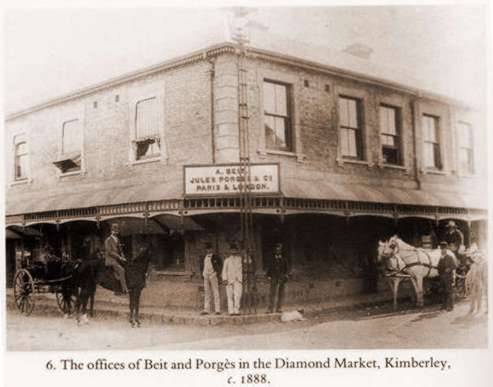
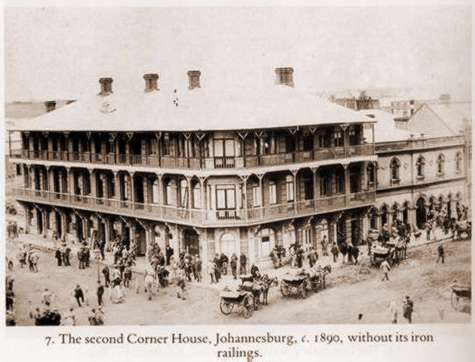
|
The Porges diamond
The Porges Diamond is a Fancy Yellow diamond weighing 78.53 carats and was bought by Harry Winston in 1962 who named it, as a tribute to the French diamond mining pioneer, Jules Porges.
Winston mounted the stone so that it may be worn either as a brooch, within a frame set with cabochon-cut emeralds and rubies or as a single stone, set within a simple ring mount.
The current owner purchased it from Harry Winston directly in 1968 and as record books indicate, the whereabouts were unknown until now.
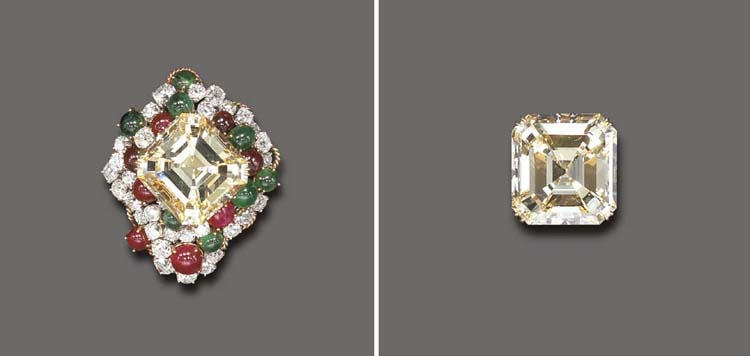
Jules Porges (1839-1921), descended from a prominent Austro-Hungarian family, was born in Vienna and was raised in Prague, where his father was a master jeweler.
By the 1860s he had settled in Paris where he quickly established himself as a principal force in the diamond trade and founded Jules Porges & Company.
Just outside Paris, he built a spectacular château in Rochefort-en-Yvelines for his wife and daughter and his residence in Paris was located on the Avenue Montaigne, where he housed an important art collection, focusing on Dutch masters such as Hals and van Dyck.
By the time diamonds were discovered in South Africa, he had amassed a tremendous fortune and was considered the leading diamond merchant in the world.
Quickly realizing the potential of these newly discovered mines, he dispatched Alfred Beit and Julius Wernher in 1873 to act as his representatives in this new venture and in 1876, Porges himself arrived in Kimberley, playing the unusual role as both consumer and producer of diamonds.
Although he had invested in the mining rights of the four major mines (De Beers, Bultfontein, Dutoitspan, and Kimberley), by 1879 he was almost completely focused on Kimberley and had become a close associate of Cecil Rhodes.
Rhodes eventually convinced the French investors to sell their shares to the newly formed De Beers firm.
Jules Porges quietly retired in 1890.
The Porges is an Asscher-cut Fancy Yellow diamond, SI1 clarity, and it figured as Christie's Magnificent Jewels sale of April 19th and 20th, 2004.
It was Lot 473 in Sale 1362, with an estimate of $600,000 to $800,000 US (sold $769.100 US).
The brooch in the photo, created by Harry Winston, is set with Old Mine and Old European cut diamonds in a freeform design around the Porges itself.
These are enhanced by scattered cabochon-cut rubies and emerald with a total approximate weight of 23.90 and 15.00 carats, respectively.
They are mounted in platinum and yellow gold.
According to the text of the auction the piece is accompanied by a gold ring mounting and a screwdriver to transfer the Porges Diamond back and forth.
Also included was a Harry Winston black suede case.
http://famousdiamonds.tripod.com/porgesdiamond.html
|
About
the social life of Jules Porgès and his wife in Paris
Source
: Emmanuel Mollot , Rochefort-en-Yvelines (2000)
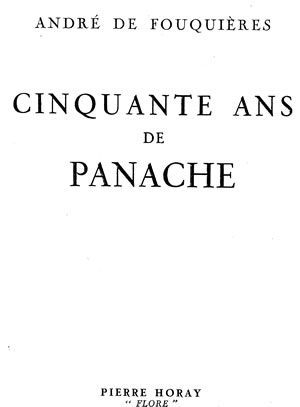 |
....
J'ai dit ce qu'étaient, avant 1914, les soirées
de l'ambassade d’Autriche-Hongrie quand, dans
les salons de l'hôtel Matignon, les plus brillants
cavaliers faisaient tourner, au rythme de la valse,
les plus jolies femmes de Paris ... et quelques têtes.
Pas de fête sans la présence du prince
de Hohenlohe, des comtes Nemès, Festeties,
Tarnovski, Schoenborn, du baron Léon de Vaux,
du baron Oscar de Gautsch et Rodolphe de Mittag, valseur
irrésistible, qui avait dérobé
le Coeur d'une grande dame de chez nous.
L'ambassade avait à Paris une véritable
annexe officieuse :
l'hôtel Porgès, avenue Montaigne.
Mme Jules Porgès, qui était viennoise,
avait fait construire ce vaste hôtel d'allure
majestueuse et de style incertain dont les salons,
emplis de toiles anciennes autant que des salles de
musée, servirent de cadre à bien des
fêtes. Elle avait aussi à Rochefort-en-Yvelines
un château confortable et somptueux à
la manière d'un Palace.
Le comte de Khevenhuller, l'ambassadeur d'Autriche-Hongrie,
le baron de Vaux, les secrétaires de l'ambassade
étaient chez eux avenue Montaigne, mais aussi
le comte Chevreau, dont l'hôtel de la rue Monsieur
est devenu propriété de Mme Georges
Menier ( Il s'agit de l'ancien hôtel du comte
de Jarnac construit sur l'emplacement d'un couvent
de Barnabites...).
Causeur brillant, Urbain Chevreau
descendait du ministre de Napoléon III, et
aussi de ce curieux personnage qui fut secrétaire
des commandements de la reine Christine de Suède
et qui prépara le mariage de Monsieur, frère
de Louis XIV avec la princesse Charlotte-Elisabeth.
Il faisait de fréquents séjours à
Lausanne, la «Babel du Gotha », d'où
il m'envoyait souvent de longues lettres emplies de
tous les potins du jour.
L'hôtel
Porgès avait été acheté
avant la guerre par une société et les
Allemands s'y installèrent en arrivant à
Paris.
Ils édifièrent dans le jardin
un fabuleux blockhaus qui n 'est guère moins
haut que l 'hôtel lui-même et qu'on a
renoncé à faire sauter.
Ce rocher de
béton commence, grâce aux mousses et
aux lichens, à acquérir quelque patine.
Au lendemain de la guerre, l'Autriche, qui n'avait
plus d'ambassade à Paris, acquit, pour sa légation,
un hôtel rue Beaujon.
En mars 1937, le ministre,
M. Vollgrüber, y donnait une réception
en l'honneur de M. Ernst Buschbeck, conservateur de
la Czernin Galerie de Vienne, venu faire une causerie
sur l'Exposition d'Art autrichien du Jeu de Paume.
M. Vollgrüber nous quitta pour devenir secrétaire
général du ministère des Affaires
Etrangères à Vienne.
M. H. D. Schmid, qui avait été le collaborateur
de son prédécesseur à la Légation
....
(André
de Fouquières, 50 ans de panache, Éditions
Pierre Horay, p. 314-315) |
|
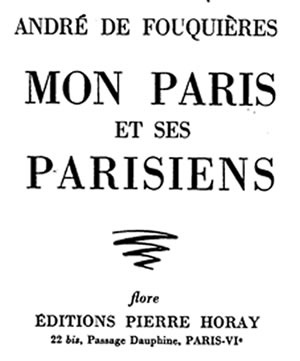 |
...
prêtaient les plus fameux comédiens du
temps: Got, Samson, Geoffroy, Madeleine Brohan, Mme
Favart.
Les invités avaient reçu des
programmes qui portaient l'en-tête : Théâtre
de Pompeï, réouverture après 1800
ans de relâche, pour cause de réparations...
Après son mariage avec la princesse Clotilde
d'Italie, le fils du roi Jérôme vendit
sa Maison Pompéienne Il ne se trouva personne
pour reprendre à son compte cette fantaisie
toute ... impériale : l’ « impluvium
» central servit quelque temps de bassin à
un montreur de phoques savants et les badauds foulèrent
les dalles où les dames de la Cour avaient
dansé leurs premières valses en balançant
leurs crinolines.
Puis, en 1891, l'année même
où « Plon-Plon » , comme on appelait
familièrement le Prince, quittait ce monde
dans un hôtel de Milan, le palais fut démoli.
Quelques vestiges, paraissant dignes d'être
conservés, furent transportés à
l'hôtel de Sully, rue Saint-Antoine.
Le banquier Jules Porgès commanda plus
tard à Samson, l'architecte élu alors
par le gratin, l'hôtel qui devait remplacer
la Maison Pompéienne.
Hôtel qu'on voit
encore aujourd'hui, mais déshonoré par
le blockhaus que les Allemands y ont dressé
pendant l'occupation.
Inexpugnable, l'énorme
monstre de béton n'aurait pu être dynamité
sans danger pour les demeures voisines.
L'hôtel
Porgès connut une période brillante.
La maîtresse de maison donnait des fêtes
somptueuses, accueillant avec une infinie bonne grâce
ses invités en haut du magnifique escalier
de marbre.
Tout se déroulait selon les
rites d'une cérémonie assez pompeuse,
mais ce que ces réunions eussent pu avoir d'un
peu solennel était joyeusement animé
par la présence de l'ambassadeur de la Double
Monarchie, le comte de Khevenhuller, hôte régulier
et plein de séduction de Mme Porgès,
par les jeunes diplomates austro-hongrois, tous incomparables
valseurs, par l'ami espagnol de la maison, le comte
de Casa-Sedano, qui apportait là sa bonne humeur
et son entrain.
Au cours d'une de ces soirées,
je conduisis le cotillon avec la fille de Mme Porgès,
la marquise de La Ferté-Meun.
Après la mort de Mme Porgès,
l'hôtel fut vendu, puis ce fut la guerre.
En
même temps qu'ils occupaient le 18, les Allemands
s'installèrent aussi au 20, dans l'hôtel
de Mme Edgar Stern, qui y avait réuni une belle
collection d'objets et de meubles Louis XVI.
Tout
fut pillé.
Après l'armistice, parmi
les oeuvres d'art volées à Mme E. Stern
et qui purent être récupérées,
on découvrit un buste de Sophie Arnoult, par
Houdon.
En témoignage de gratitude pour leurs
trésors retrouvés, Mme Stern et ses
enfants en firent don au musée du Louvre.
Aujourd'hui, ces deux résidences du 18 et du
20 sont la propriété de la Société
des Glaces de Saint. Gobain.
(André
de Fouquières, Mon Paris et ses Parisiens,
Éditions Pierre Horay, p. 84-85) |
|
|
|
 |